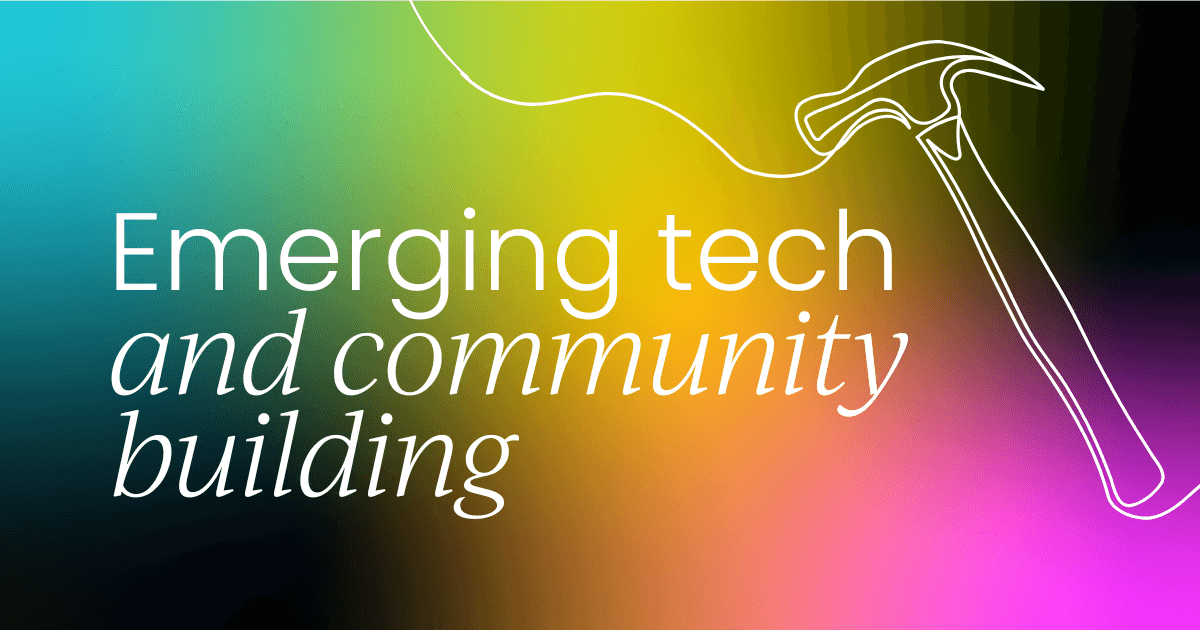Community is changing.
The tools we use, the expectations of our members, and the pace at which we adapt all continue to shift. When we think about community today, it’s not just a place or a Slack group or a Twitter feed.
It’s an experience powered by tools, fueled by trust, and increasingly shaped by technology.
As someone deeply embedded in digital strategy and innovation, I’ve spent the past few years working with leading brands to build scalable, impactful communities that support growth. And in that time, one thing has become very clear: the future of community is going to look different.
Not because the fundamentals will disappear, but because the way we deliver them will be redefined by technology.
Let’s take a look at what that future could look like and how we can start preparing now.
Understanding where we are
To get a handle on the future, I often turn to the McKinsey Three Horizons of Growth model. Originally created to evaluate emerging technology and market opportunities, it offers a useful way to view community evolution too.
- Horizon 1 is our present. It’s where incremental change happens. Think: adding new content formats to Instagram, or tweaking your Slack onboarding workflow.
- Horizon 2 is the near future – emerging technologies starting to break into the mainstream. Think about how AI is moving from novelty to necessity.
- Horizon 3 is the long-term vision – new, experimental technologies that are just starting to gain traction. Blockchain, decentralized platforms, and custom AI agents fall into this category.
Community, today, is largely operating in Horizon 1. We’re using the same platforms, improving processes, and slowly iterating. But if we want to meet people where they’re headed – not just where they are – we have to look to Horizons 2 and 3.
The future is community-first
Back in 2011, I started working in this space. I remember looking at the Martech 5000 landscape and seeing only a few hundred tools. Today, there are over 11,000. That explosion isn’t just about marketing – it’s a reflection of how digital touchpoints have fragmented.
People are spending more time online than ever, but their attention is split across countless micro-platforms. The upside? It’s never been easier to meet people where they are. The downside? It’s never been harder to earn their attention consistently.
Micro-communities are on the rise. From private Discords to niche Patreons, people are choosing depth over breadth. If you're not already researching paid micro-communities, start now. There’s almost no public data on them, but they’re growing fast – and they’re redefining what engagement looks like.
The future is AI
We’ve all seen the hype cycle around AI. But if you strip away the noise, the signal is clear: AI isn’t going away. It’s going everywhere.
Globally, governments are investing heavily in AI infrastructure. Just recently, Canada passed its largest-ever bill focused entirely on AI preparedness. The writing’s on the wall.
But what does that mean for customer community builders?
It means we can stop treating AI as a novelty and start using it as a tool. And not just for content creation. AI has the potential to power moderation, automate engagement, personalize onboarding, and even enhance the emotional intelligence of our community experiences.
One example I love is the rise of custom GPTs. Unlike general AI models that pull from the entire internet, custom GPTs can be trained on your own materials – your onboarding docs, your community guidelines, your brand voice.
Imagine a custom community assistant that can answer member questions, offer advice, and even connect people with similar interests – all within the values and context of your brand.
The key? Prototype before you go live. Break your own thing before it breaks in front of your audience.
Consider the cautionary tale of a car dealership in Ohio that deployed an AI chatbot without clear parameters. A user jokingly offered to buy a car for $1, and the bot accepted. In that state, it was a legally binding contract. Compare that with Expedia, which has been quietly building AI into its platform to help users plan trips based on budget and occasion. Smart, safe, and centered on real utility.
The future is on chain
Let’s talk blockchain.
Yes, it’s a buzzword. Yes, it can be divisive. But beyond the headlines, there are tangible, community-first use cases that deserve your attention.
Blockchain adoption is growing at a rate that, in some ways, is faster than the internet did in its early years. What’s driving this? Real utility. Let me give you a couple of examples.
Proof of participation: POAPs
Bayer ran a pilot with POAP – short for “Proof of Attendance Protocol.” Participants received a digital badge (a non-transferable NFT) that proved they attended an event or meeting. These tokens are more than digital swag – they're verifiable artifacts of engagement.
Imagine using them to track event attendance, reward repeat participation, or even unlock deeper tiers of access. It’s a low-stakes, high-impact way to dip your toe into Web3.
Incentivizing loyalty with digital assets
Nike’s SWOOSH platform is another standout. They turned their brand legacy into digital assets – minting limited-edition NFTs representing key moments in Nike’s history. These weren’t just collector’s items. They became unlocks for exclusive shoes, events, and community access.
This is where blockchain shines: verifiable ownership, transparent access, and scalable reward mechanisms. You can prove someone is a “real fan,” not based on what they say, but based on what they’ve done – and use that proof to reward them accordingly.
A strategic roadmap: How to start building for the future
So how do you start integrating all of this into your community strategy without overwhelming your team (or yourself)?
I use a simple structure:
1. Get alignment
Start by forming a small task force of stakeholders across departments. Your first goal isn’t implementation – it’s exposure. Go to conferences, take courses, join forums, talk to people already experimenting with AI and blockchain.
Innovation doesn’t happen in silos. You need internal champions and external inspiration.
2. Prototype and test
Don’t build a 12-month roadmap just yet. Start small. Build a custom GPT based on your community’s onboarding documents. Issue POAPs for your next event. Test, tweak, and evaluate.
Ask questions like:
- Does this add value for our members?
- Does this reduce friction?
- Does this scale ethically?
Always get legal involved early – especially with AI and blockchain tools. And always, always test on yourself before releasing to your community.
3. Celebrate early adopters
Not everyone will be ready to jump into an on-chain community or engage with an AI-powered assistant. That’s okay. Focus on the ones who are.
Create special spaces, rewards, or recognition for your early adopters. Use them as your beta testers and feedback loop. Their enthusiasm can become contagious – and give you the credibility you need to bring others on board.
Collaborate to build what’s next
Some of the most exciting community innovation today is coming from collaboration.
A great example is the American Cancer Society, which partnered with Gitcoin to launch a blockchain-based grant program. They opened up $1 million in funding for ideas around patient support, health equity, and cancer screening.
Using quadratic funding and blockchain infrastructure, they created a transparent, community-driven grant process. Members of the public could propose ideas, signal support through donations, and track where the funds went – all on chain.
It’s a model that blends accountability, engagement, and impact. And it’s exactly the kind of thinking we need to bring into more community programs.
Get curious, get building
If there’s one thing I hope you take away, it’s this: the future is being built right now. Not in theory. Not in whitepapers. But in the experiments you run, the prototypes you launch, and the risks you take.
- Try building a custom GPT. Start with your FAQ or onboarding guide.
- Issue your first POAP. See who shows up.
- Talk to your legal team about what an on-chain experience might look like for your brand.
And above all, stay curious. Follow the weird corners of the internet. Go to the event nobody else at your company is attending. Read the Reddit thread. Break your own thing before someone else does.
Because this digital frontier? It’s not coming. It’s already here.


 5 min read
5 min read
 Follow us on LinkedIn
Follow us on LinkedIn



